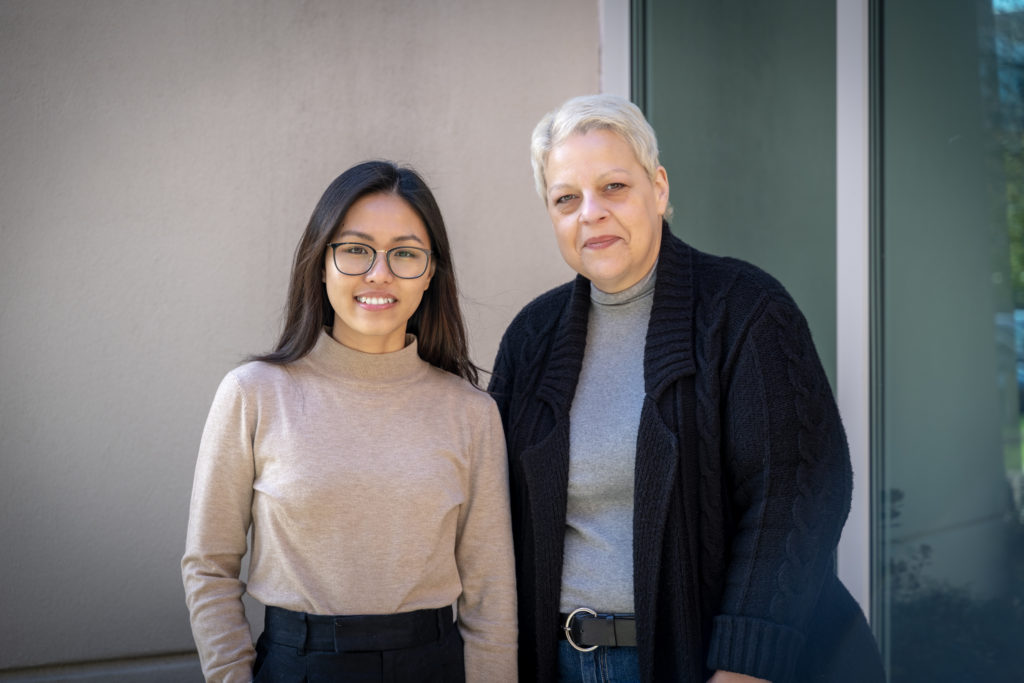Diversity in Design Pipeline Scholarship is Latest High-Profile Opportunity for Aspiring Sustainable Design Professional

My Grumbling ’24, left, and Assistant Professor of Interior + Spatial Design Lynn Capirsello, right
This fall, luxury home appliance brand Thermador and the Interior Design Society named My Grumbling as one of five recipients of their 2023-2024 Diversity in Design Pipeline Scholarship and professional development program.
Grumbling is an Interior + Spatial Design major in Russell Sage College’s Class of 2024. She is the only Diversity in Design winner from an interior design program at a small, private college; the other students represent public research institutions many times the size of Sage.
In November, Grumbling traveled to Thermador’s headquarters in Chicago to meet fellow winners and the acclaimed professionals who will mentor the student-designers.
“We had the opportunity to watch amazing food demonstrations and cook using their most high-tech appliances,” she said. “Additionally, we had one-on-one connections with mentors and received real-life advice.”
In the coming year, she’ll join online roundtables with her cohort. “I will have the opportunity to learn from five mentors with different expertise, ranging from sustainability and technical aspects of kitchen and bath design, to communication, finding clients, and managing a successful practice,” she said.
The Diversity in Design scholarship is the second high-profile professional development opportunity Grumbling received from a national organization. Last year, she participated in the New Buildings Institute’s Next Gen program for underrepresented students interested in a career in building efficiency.
“Interior and spatial design captivates me due to its unique ability to combine artistic expression with functionality,” said Grumbling, whose goal is a career in sustainable and affordable residential design. “I see interior design as a great creative outlet that also provides a way to make this world a better place.”
Her interest in sustainable and affordable design is rooted in her childhood in rural southern Vietnam. “Coming from a humble background, I decided to pursue this degree in the hopes of helping other people,” she said. “My hope is to create safe spaces where people can thrive and pursue their dreams.”
Grumbling said Sage’s small, supportive Interior + Spatial Design program is putting her on track to meet her goals.
“Close interaction with both my instructors and classmates creates an enriching educational atmosphere that encourages creativity, collaboration, and a deeper understanding of the subject matter.“ She added that classes in graphic design, studio art, and art history broaden her knowledge of design-related subjects, and out-of-the-classroom learning experiences help her build a professional network.
Last semester, Grumbling, along with some of her classmates, received Sage’s Scrimshaw/Stern Travel Award, which enabled them to travel to the High Point Market in North Carolina. The market is the world’s largest home furnishings industry trade show, and she made valuable contacts at educational sessions and social events.
Earlier this year, Russell Sage’s Career and Self-Discovery Center helped Grumbling arrange a job shadow with alumna Kait Bates ‘22 and her colleagues at Hyman Hayes Associates in Latham, New York.
“The experience allowed me to better understand what a typical day looks like for an interior designer in an architectural firm,” said Grumbling. “I spent half a day in the office with Kait and the rest visiting showrooms with the director of the interior design department.”
Assistant Professor of Interior + Spatial Design Lynn Capirsello described Grumbling as an intelligent and thoughtful design student. “She takes chances and looks for opportunities to enhance her career and learning objectives,” said Capirsello. “Her passion for learning inspires her peers as well as her faculty.”
Once she receives her BFA, Grumbling plans to pursue the WELL AP credential while she works under a licensed architect or designer to accumulate the work experience required to sit for the National Council for Interior Design Qualification exam. The NCIDQ exam leads to professional certification; the WELL AP credential denotes expertise in improving human health through built environments.
“Design has the power to evoke emotions, inspire productivity, and foster a sense of well-being,” Grumbling said, excited for her future. “This field not only allows me to express my creativity but also offers the opportunity to transform and enhance the way people experience and interact with their environments and improve their quality of life.”

